2007 Hyundai Accent fluid
[x] Cancel search: fluidPage 234 of 282
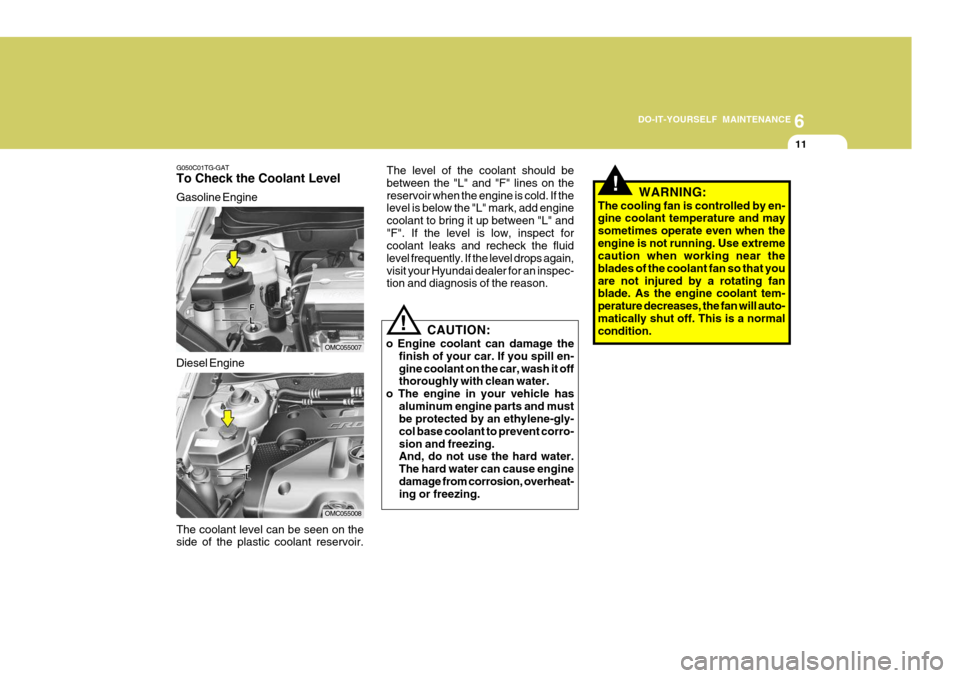
6
DO-IT-YOURSELF MAINTENANCE
11
G050C01TG-GAT To Check the Coolant Level Gasoline Engine The coolant level can be seen on the side of the plastic coolant reservoir.
OMC055007
OMC055008
Diesel Engine The level of the coolant should be between the "L" and "F" lines on thereservoir when the engine is cold. If the level is below the "L" mark, add engine coolant to bring it up between "L" and"F". If the level is low, inspect for coolant leaks and recheck the fluid level frequently. If the level drops again,visit your Hyundai dealer for an inspec- tion and diagnosis of the reason.
!WARNING:
The cooling fan is controlled by en- gine coolant temperature and may sometimes operate even when theengine is not running. Use extreme caution when working near the blades of the coolant fan so that youare not injured by a rotating fan blade. As the engine coolant tem- perature decreases, the fan will auto-matically shut off. This is a normal condition.
! CAUTION:
o Engine coolant can damage the finish of your car. If you spill en- gine coolant on the car, wash it off thoroughly with clean water.
o The engine in your vehicle has
aluminum engine parts and mustbe protected by an ethylene-gly- col base coolant to prevent corro-sion and freezing. And, do not use the hard water. The hard water can cause enginedamage from corrosion, overheat- ing or freezing.
Page 237 of 282
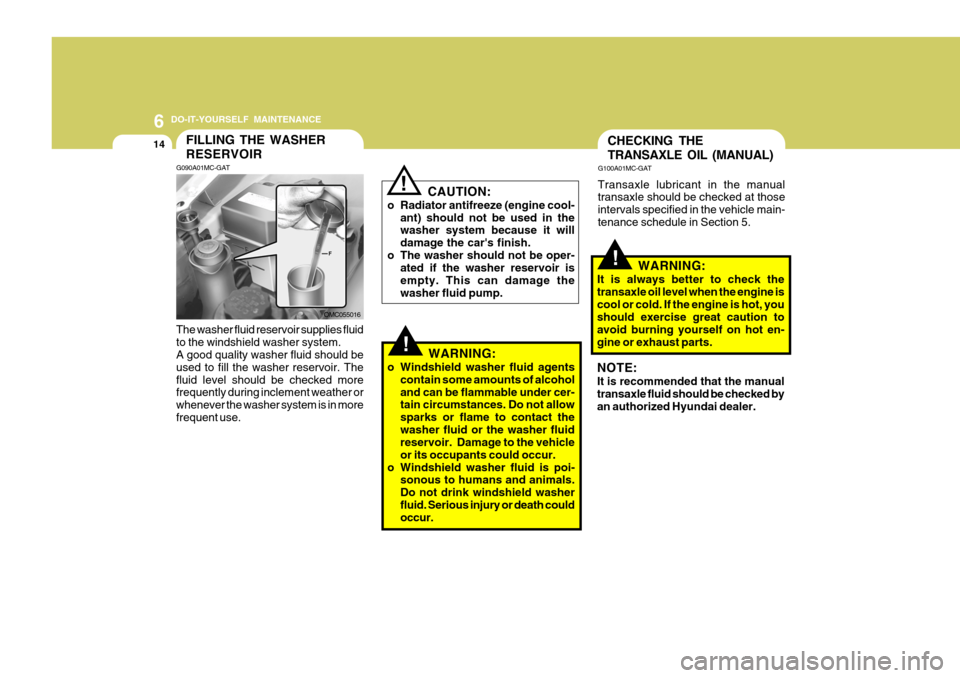
6 DO-IT-YOURSELF MAINTENANCE
14
!
CAUTION:
o Radiator antifreeze (engine cool- ant) should not be used in the washer system because it will damage the car's finish.
o The washer should not be oper- ated if the washer reservoir isempty. This can damage thewasher fluid pump.!
WARNING:
o Windshield washer fluid agents contain some amounts of alcohol and can be flammable under cer- tain circumstances. Do not allow sparks or flame to contact thewasher fluid or the washer fluid reservoir. Damage to the vehicle or its occupants could occur.
o Windshield washer fluid is poi- sonous to humans and animals.Do not drink windshield washerfluid. Serious injury or death could occur.
CHECKING THE TRANSAXLE OIL (MANUAL)
G100A01MC-GAT
Transaxle lubricant in the manual transaxle should be checked at those intervals specified in the vehicle main-tenance schedule in Section 5.
!WARNING:
It is always better to check the transaxle oil level when the engine iscool or cold. If the engine is hot, you should exercise great caution to avoid burning yourself on hot en-gine or exhaust parts. NOTE: It is recommended that the manual transaxle fluid should be checked by an authorized Hyundai dealer.
FILLING THE WASHER RESERVOIR
G090A01MC-GAT The washer fluid reservoir supplies fluid to the windshield washer system. A good quality washer fluid should be used to fill the washer reservoir. Thefluid level should be checked more frequently during inclement weather or whenever the washer system is in morefrequent use. OMC055016
Page 238 of 282

6
DO-IT-YOURSELF MAINTENANCE
15CHECKING THE TRANSAXLE FLUID (AUTOMATIC)
G110A01MC-AAT Transaxle fluid in the automatic transaxle should be checked at those intervals specified in the vehicle main- tenance schedule in Section 5. NOTE: Automatic transaxle fluid is basi- cally a red color. As driving distance increases, the fluid color turns dark-ish red gradually. It is normal condi- tion and you should not judge the need to replace based upon thechanging color. You must replace the automatic transaxle fluid in accordance withintervals specified in the vehicle maintenance schedule in section 5.
!WARNING:
The transaxle fluid level should be checked when the engine is at nor- mal operating temperature. This means that the engine, radiator,exhaust system etc., are very hot. Exercise great care not to burn your- self during this procedure. G110D02A-GAT To Check the Transaxle Fluid Level Park the car on level ground with the parking brake engaged. When thetransaxle fluid level is checked, the transaxle fluid should be at normal operating temperature and the engineidling. While the engine is idling, apply the brakes and move the gear selectorlever from "P" to each of its other positions -- "R", "N", "D", "2", "L" -- and then return to "N" or "P". With theengine still idling:
OMC035014
Page 239 of 282
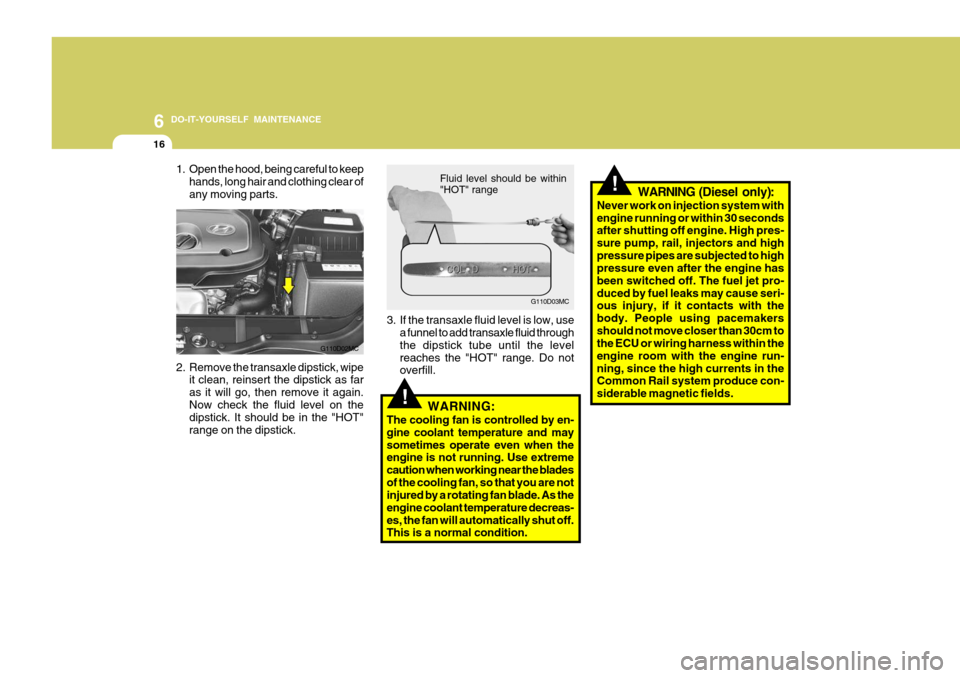
6 DO-IT-YOURSELF MAINTENANCE
16
!
!
3. If the transaxle fluid level is low, use
a funnel to add transaxle fluid through the dipstick tube until the levelreaches the "HOT" range. Do not overfill.
WARNING:
The cooling fan is controlled by en- gine coolant temperature and maysometimes operate even when the engine is not running. Use extreme caution when working near the bladesof the cooling fan, so that you are not injured by a rotating fan blade. As the engine coolant temperature decreas-es, the fan will automatically shut off. This is a normal condition. WARNING (
Diesel only):
Never work on injection system with engine running or within 30 seconds after shutting off engine. High pres- sure pump, rail, injectors and highpressure pipes are subjected to high pressure even after the engine has been switched off. The fuel jet pro-duced by fuel leaks may cause seri- ous injury, if it contacts with the body. People using pacemakersshould not move closer than 30cm to the ECU or wiring harness within the engine room with the engine run-ning, since the high currents in the Common Rail system produce con- siderable magnetic fields.
G110D03MC
Fluid level should be within "HOT" range
1. Open the hood, being careful to keep
hands, long hair and clothing clear of any moving parts.
2. Remove the transaxle dipstick, wipe it clean, reinsert the dipstick as faras it will go, then remove it again.Now check the fluid level on the dipstick. It should be in the "HOT" range on the dipstick. G110D02MC
Page 240 of 282
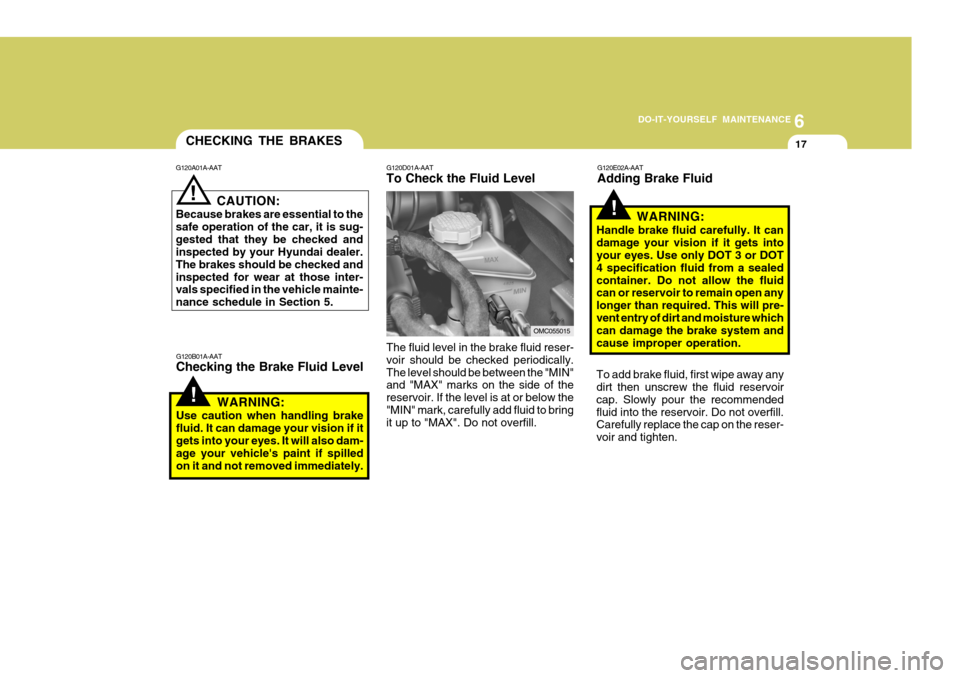
6
DO-IT-YOURSELF MAINTENANCE
17
!
CHECKING THE BRAKES
G120A01A-AAT
G120B01A-AAT Checking the Brake Fluid Level
! CAUTION:
Because brakes are essential to the safe operation of the car, it is sug-gested that they be checked and inspected by your Hyundai dealer. The brakes should be checked andinspected for wear at those inter- vals specified in the vehicle mainte- nance schedule in Section 5.
WARNING:
Use caution when handling brakefluid. It can damage your vision if itgets into your eyes. It will also dam- age your vehicle's paint if spilled on it and not removed immediately.
G120D01A-AAT To Check the Fluid Level
OMC055015
The fluid level in the brake fluid reser- voir should be checked periodically.The level should be between the "MIN" and "MAX" marks on the side of the reservoir. If the level is at or below the"MIN" mark, carefully add fluid to bring it up to "MAX". Do not overfill.
!
G120E02A-AAT Adding Brake Fluid
WARNING:
Handle brake fluid carefully. It can damage your vision if it gets into your eyes. Use only DOT 3 or DOT 4 specification fluid from a sealedcontainer. Do not allow the fluid can or reservoir to remain open any longer than required. This will pre-vent entry of dirt and moisture which can damage the brake system and cause improper operation. To add brake fluid, first wipe away any dirt then unscrew the fluid reservoir cap. Slowly pour the recommendedfluid into the reservoir. Do not overfill. Carefully replace the cap on the reser- voir and tighten.
Page 241 of 282

6 DO-IT-YOURSELF MAINTENANCE
18
G140B01A-AAT Checking the Air Conditioning Operation
1. Start the engine and let it run at afast idle for several minutes with the air conditioning set at the maximum cold setting.
2. If the air coming out of the in-dash vents is not cold, have the air condi-tioning system inspected by yourHyundai dealer.
G140C01A-AAT Lubrication To lubricate the compressor and the seals in the system, the air conditioning should be run for at least 10 minuteseach week. This is particularly important during cool weather when the air condi- tioning system is not otherwise in use.
! CAUTION:
Running the air conditioning sys- tem for extended periods of time with a low refrigerant level may damage the compressor.
AIR CONDITIONING CARE
G140A01A-AAT Keeping the Condenser Clean The air conditioning condenser (and engine radiator) should be checkedperiodically for accumulation of dirt, dead insects, leaves, etc. These can interfere with maximum cooling effi-ciency. When removing such accumu- lations, brush or hose them away care- fully to avoid bending the cooling fans.CHECKING THE CLUTCH FLUID
G130A01A-AAT (If Installed) To Check the Clutch Fluid The clutch fluid level in the master cylinder should be checked when per- forming other under hood services. Thesystem should be checked for leakage at the same time. Check to make certain that the clutchfluid level is between the "MAX" and "MIN" level markings on the fluid reser- voir. Fill as required. Fluid loss indi-cates a leak in the clutch system which should be inspected and repaired im- mediately. Consult your Hyundai dealer.
G130A01MC
Right-hand Drive Type
Page 245 of 282

6 DO-IT-YOURSELF MAINTENANCE
22
!
CHECKING THE BATTERY
G210A01A-AAT
WARNING:
Batteries can be dangerous! When working with batteries, carefully ob-serve the following precautions to avoid serious injuries. The fluid in the battery contains a strong solution of sulfuric acid, which is poi- sonous and highly corrosive. Be careful not to spill it on yourself or the car. If youdo spill battery fluid on yourself, imme- diately do the following:
OMC055018
G200C01CM-GAT Power Connector
NOTE:
o If the power connector is pulled
up from the fuse panel, the warn- ing chime, audio, clock and inte- rior lamps, etc., will not operate. The following items must be resetafter replacement. - Digital Clock - Trip computer
- Automatic heating and cooling control system
- Audio
o Even though the power connector is pulled up, the battery can stillbe discharged by operation of theheadlights or other electrical de- vices.
Your vehicle is equipped with a power connector to prevent battery discharge if your vehicle is parked without being operated for prolonged periods. Use thefollowing procedures before parking the vehicle for prolonged periods.
1. Turn off the engine.
2. Turn off the headlights and tail lights.
3. Open the driver’s side panel cover
and pull up the power connector.
4. Insert the power connector in the
opposite direction.
G200F01MC
Page 246 of 282
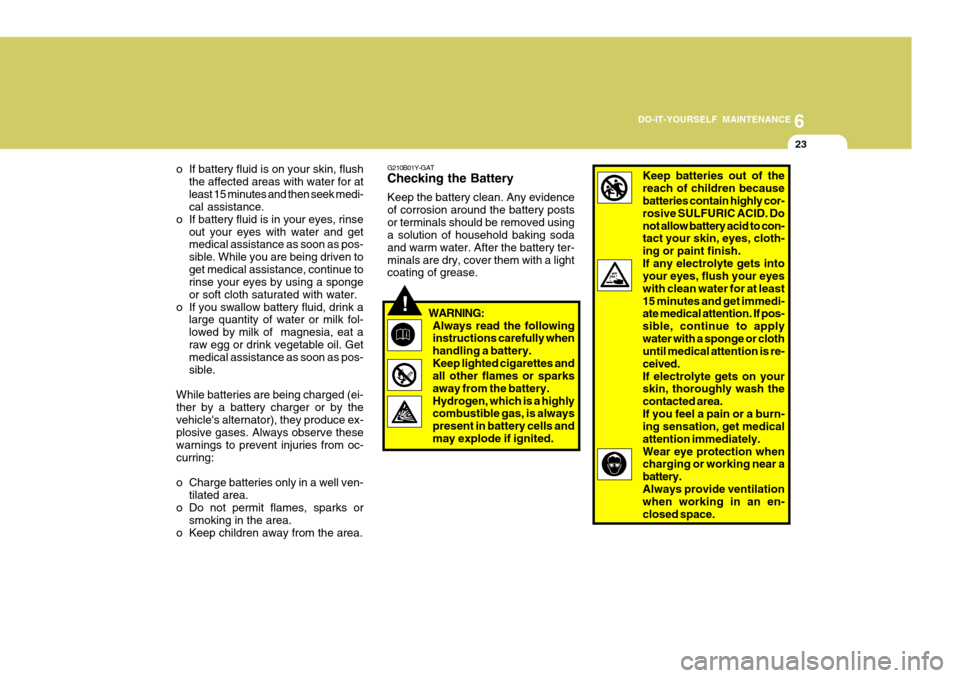
6
DO-IT-YOURSELF MAINTENANCE
23
G210B01Y-GAT Checking the Battery Keep the battery clean. Any evidence of corrosion around the battery postsor terminals should be removed using a solution of household baking soda and warm water. After the battery ter-minals are dry, cover them with a light coating of grease.
Keep batteries out of the reach of children because batteries contain highly cor- rosive SULFURIC ACID. Donot allow battery acid to con- tact your skin, eyes, cloth- ing or paint finish.If any electrolyte gets into your eyes, flush your eyes with clean water for at least15 minutes and get immedi- ate medical attention. If pos- sible, continue to applywater with a sponge or cloth until medical attention is re- ceived.If electrolyte gets on your skin, thoroughly wash the contacted area.If you feel a pain or a burn- ing sensation, get medical attention immediately.Wear eye protection when charging or working near a battery.Always provide ventilation when working in an en- closed space.
WARNING: Always read the following instructions carefully when handling a battery.Keep lighted cigarettes and all other flames or sparks away from the battery.Hydrogen, which is a highly combustible gas, is always present in battery cells andmay explode if ignited.!
o If battery fluid is on your skin, flush the affected areas with water for at least 15 minutes and then seek medi- cal assistance.
o If battery fluid is in your eyes, rinse
out your eyes with water and getmedical assistance as soon as pos- sible. While you are being driven toget medical assistance, continue to rinse your eyes by using a sponge or soft cloth saturated with water.
o If you swallow battery fluid, drink a large quantity of water or milk fol-lowed by milk of magnesia, eat araw egg or drink vegetable oil. Get medical assistance as soon as pos- sible.
While batteries are being charged (ei-ther by a battery charger or by thevehicle's alternator), they produce ex- plosive gases. Always observe these warnings to prevent injuries from oc-curring:
o Charge batteries only in a well ven- tilated area.
o Do not permit flames, sparks or
smoking in the area.
o Keep children away from the area.